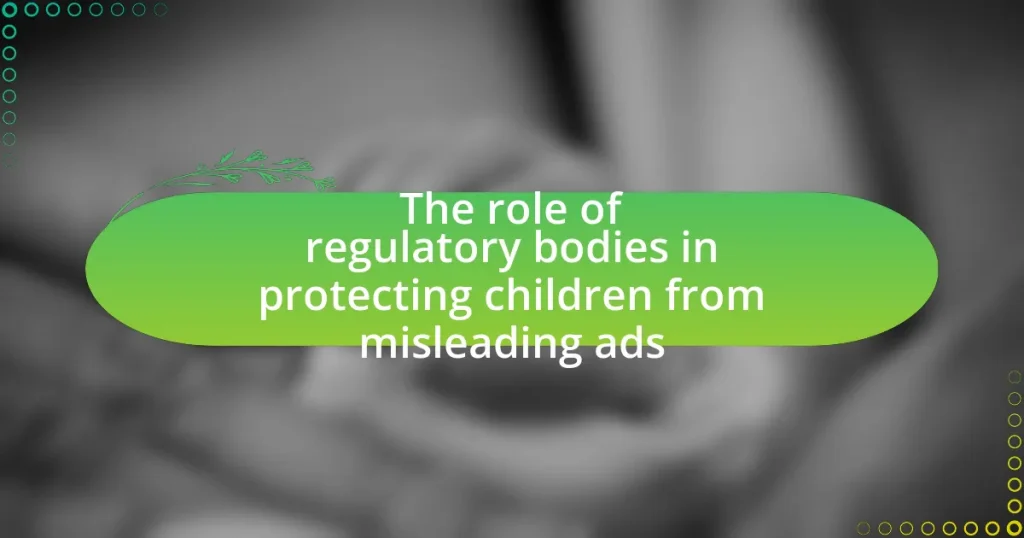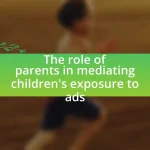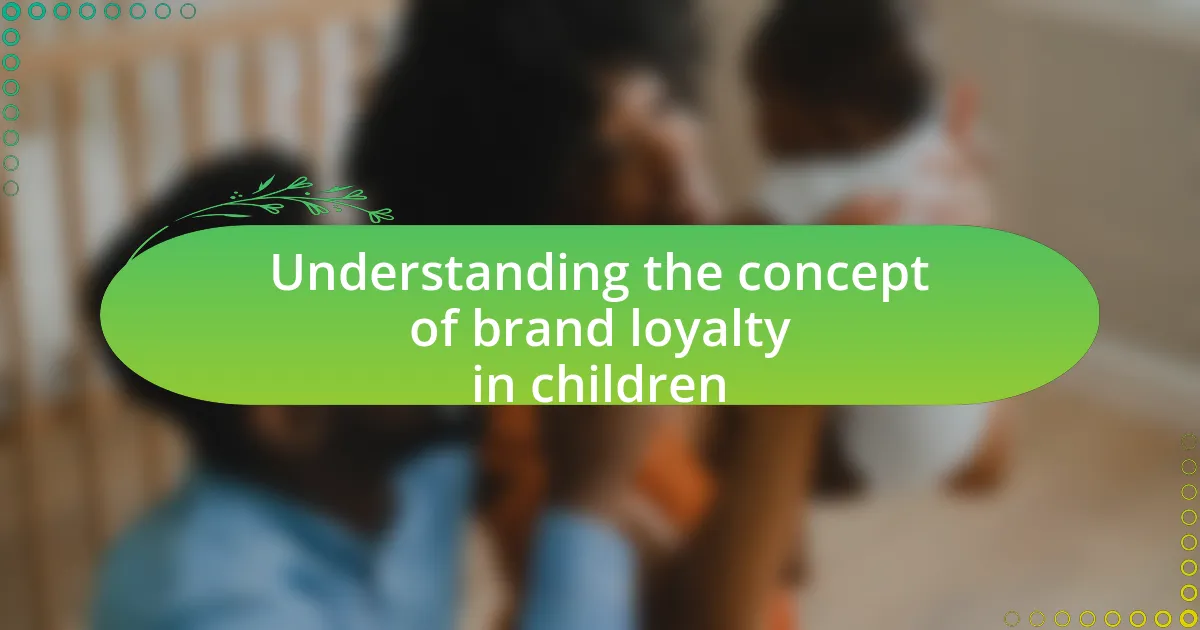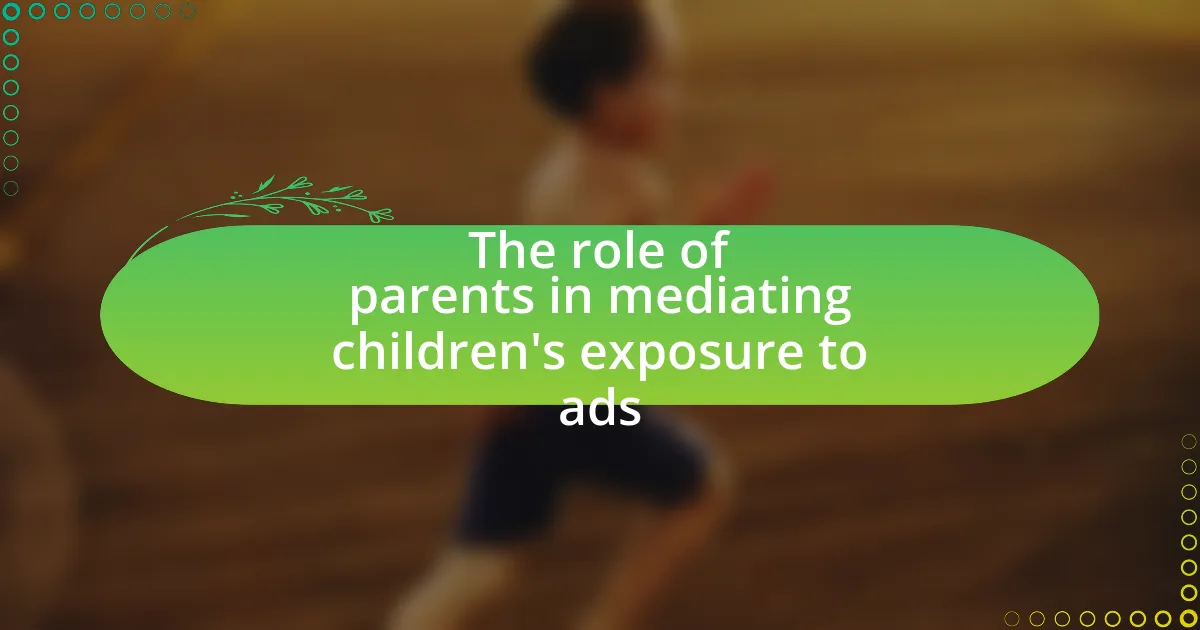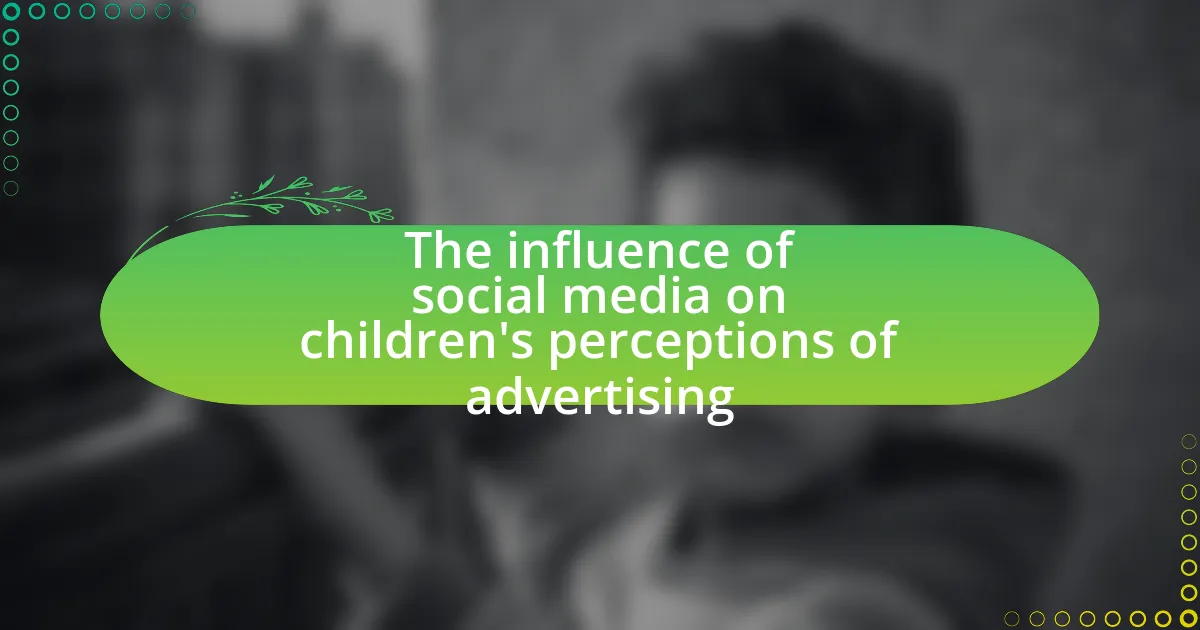Regulatory bodies, such as the Federal Trade Commission (FTC) in the United States and the Advertising Standards Authority (ASA) in the United Kingdom, play a vital role in protecting children from misleading advertisements. These organizations establish and enforce guidelines to ensure that advertising content is truthful and appropriate for young audiences, addressing the psychological vulnerabilities of children who may not possess the critical thinking skills to discern deceptive marketing tactics. The article explores how regulatory bodies define misleading advertisements, the criteria used for classification, and the challenges they face in a rapidly evolving digital landscape. It also highlights the importance of public awareness, parental involvement, and collaboration with educational institutions in combating misleading ads targeted at children.
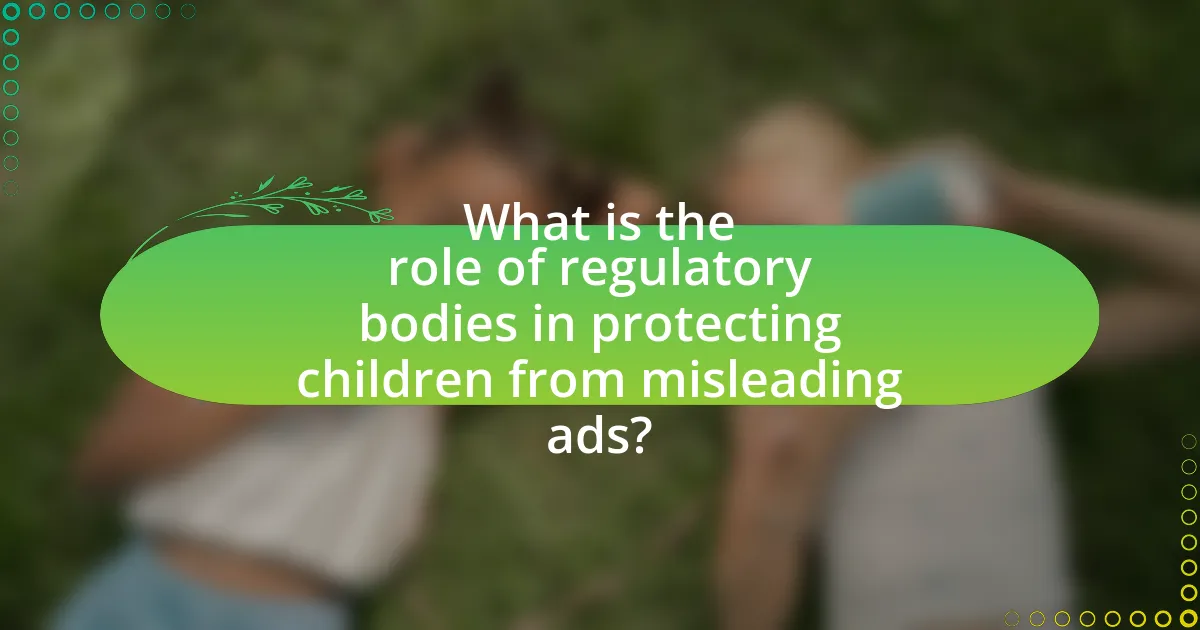
What is the role of regulatory bodies in protecting children from misleading ads?
Regulatory bodies play a crucial role in protecting children from misleading advertisements by establishing and enforcing guidelines that ensure advertising content is truthful and appropriate for young audiences. These organizations, such as the Federal Trade Commission (FTC) in the United States, monitor advertising practices and can impose penalties on companies that violate regulations designed to safeguard children from deceptive marketing tactics. For instance, the Children’s Online Privacy Protection Act (COPPA) mandates that websites and online services directed at children must obtain parental consent before collecting personal information, thereby reducing the risk of misleading ads targeting minors.
How do regulatory bodies define misleading advertisements?
Regulatory bodies define misleading advertisements as communications that contain false or deceptive claims that can mislead consumers regarding the nature, characteristics, or benefits of a product or service. For instance, the Federal Trade Commission (FTC) in the United States stipulates that advertisements must not omit material information that could mislead consumers, and they must be substantiated by evidence. This definition is supported by various regulations and guidelines that emphasize the importance of truthfulness and clarity in advertising, particularly to protect vulnerable populations such as children from being misled by exaggerated or false claims.
What criteria are used to classify an ad as misleading?
An ad is classified as misleading based on criteria such as false claims, deceptive practices, and omission of critical information. Regulatory bodies assess whether the ad misrepresents the product or service, creates a false impression, or fails to disclose important facts that could influence consumer decisions. For instance, the Federal Trade Commission (FTC) in the United States evaluates ads for truthfulness and substantiation, ensuring that claims are backed by evidence. Misleading ads can lead to consumer deception, particularly among vulnerable populations like children, prompting regulatory action to protect them from exploitation.
How do these definitions vary across different regions?
Definitions of misleading advertisements vary significantly across different regions due to cultural, legal, and regulatory differences. For instance, in the United States, the Federal Trade Commission defines misleading advertising as any representation that is likely to mislead consumers acting reasonably under the circumstances, emphasizing the need for truthfulness and substantiation. In contrast, the European Union’s Audiovisual Media Services Directive provides a broader definition that includes the protection of minors from harmful content, reflecting a more precautionary approach to child welfare. Additionally, countries like Australia have specific guidelines that focus on the impact of advertisements on children’s health and well-being, illustrating regional priorities in child protection. These variations highlight how local values and legal frameworks shape the understanding and enforcement of regulations concerning misleading advertisements aimed at children.
Why is it important to protect children from misleading ads?
Protecting children from misleading ads is crucial because they are particularly vulnerable to manipulation and may not possess the critical thinking skills necessary to discern truth from deception. Research indicates that children under the age of eight are unable to understand the persuasive intent of advertisements, making them more susceptible to believing misleading claims. For instance, a study published in the Journal of Consumer Research found that children are more likely to accept advertisements as truthful, which can lead to unhealthy consumption habits and unrealistic expectations. Therefore, regulatory bodies play a vital role in ensuring that advertising directed at children is truthful and not misleading, thereby safeguarding their well-being and promoting informed decision-making.
What psychological effects do misleading ads have on children?
Misleading ads have significant psychological effects on children, including distorted perceptions of reality and increased materialism. Children exposed to misleading advertisements often develop unrealistic expectations about products, leading to disappointment and confusion when the actual product does not meet those expectations. Research indicates that children are particularly vulnerable to advertising messages due to their cognitive development stage, which makes it difficult for them to critically evaluate the information presented. A study published in the Journal of Consumer Research found that children aged 8 to 12 are more likely to believe claims made in advertisements, resulting in a higher likelihood of developing materialistic values and a desire for products that may not be beneficial or necessary. This manipulation can also contribute to issues such as low self-esteem and body image concerns, as children compare themselves to idealized representations in ads.
How do misleading ads influence children’s purchasing behavior?
Misleading ads significantly influence children’s purchasing behavior by creating false perceptions about products, leading to increased desire and demand. Research indicates that children, due to their cognitive development stage, often cannot distinguish between advertising and reality, making them more susceptible to persuasive techniques used in misleading advertisements. For instance, a study published in the Journal of Consumer Research found that children aged 8 to 12 were more likely to request products they saw in ads that exaggerated benefits or misrepresented features. This susceptibility is compounded by the emotional appeal often used in such ads, which can manipulate children’s feelings and desires, ultimately driving them to influence their parents’ purchasing decisions.
What are the main regulatory bodies involved in this protection?
The main regulatory bodies involved in protecting children from misleading ads include the Federal Trade Commission (FTC) in the United States, the Advertising Standards Authority (ASA) in the United Kingdom, and the European Advertising Standards Alliance (EASA) in Europe. The FTC enforces laws against deceptive advertising practices, ensuring that advertisements targeting children are truthful and not misleading. The ASA sets standards for advertising in the UK, specifically focusing on protecting children from harmful or misleading content. EASA works to harmonize advertising standards across Europe, promoting responsible advertising practices that safeguard children. These organizations collectively establish guidelines and regulations that aim to protect children from exploitation in advertising.
What roles do organizations like the FTC and ASA play?
Organizations like the FTC (Federal Trade Commission) and ASA (Advertising Standards Authority) play crucial roles in regulating advertising practices to protect consumers, particularly children, from misleading advertisements. The FTC enforces laws against deceptive advertising and ensures that marketing practices are truthful and not misleading, which is vital for safeguarding children who may not fully understand advertising tactics. The ASA, operating in the UK, similarly oversees advertising standards, ensuring that ads are responsible and do not exploit children’s inexperience or credulity. Both organizations establish guidelines and take enforcement actions against violators, thereby promoting ethical advertising practices that prioritize the welfare of children.
How do international regulatory bodies contribute to this effort?
International regulatory bodies contribute to the effort of protecting children from misleading ads by establishing guidelines and standards that govern advertising practices. These bodies, such as the International Chamber of Commerce and the World Health Organization, create frameworks that specifically address the vulnerabilities of children in advertising contexts. For instance, the International Chamber of Commerce’s Code of Advertising Practice includes provisions that prohibit misleading claims and require that advertisements directed at children be clearly distinguishable from content. This ensures that children are not exposed to deceptive marketing tactics. Additionally, these organizations often collaborate with national regulatory agencies to enforce compliance and promote best practices, thereby enhancing the overall effectiveness of child protection measures in advertising.
How do regulatory bodies enforce guidelines against misleading ads?
Regulatory bodies enforce guidelines against misleading ads through a combination of monitoring, investigation, and penalties. These organizations, such as the Federal Trade Commission (FTC) in the United States, actively review advertisements to ensure compliance with established truth-in-advertising laws. When misleading claims are identified, regulatory bodies can initiate investigations, often prompted by consumer complaints or industry whistleblowers.
For instance, the FTC has the authority to issue fines, require corrective advertising, and even pursue legal action against companies that violate advertising standards. In 2020, the FTC took action against several companies for deceptive marketing practices, demonstrating its commitment to enforcing guidelines. This enforcement mechanism is crucial in protecting consumers, particularly children, from misleading advertisements that can influence their purchasing decisions and perceptions.
What methods are used to monitor advertisements targeted at children?
Regulatory bodies use several methods to monitor advertisements targeted at children, including content analysis, compliance checks, and public reporting mechanisms. Content analysis involves reviewing advertisements to ensure they adhere to established guidelines regarding appropriateness and truthfulness. Compliance checks are conducted to verify that advertisers follow regulations set by organizations such as the Federal Trade Commission (FTC) in the United States, which enforces laws against deceptive advertising practices. Public reporting mechanisms allow parents and guardians to report misleading or inappropriate ads, which can trigger investigations by regulatory agencies. These methods collectively aim to protect children from misleading advertisements and ensure that marketing practices are ethical and responsible.
How are violations of advertising regulations addressed?
Violations of advertising regulations are addressed through enforcement actions taken by regulatory bodies, which monitor compliance and impose penalties for non-compliance. For instance, the Federal Trade Commission (FTC) in the United States investigates misleading advertisements and can issue fines, require corrective advertising, or even pursue legal action against violators. These actions are supported by laws such as the Children’s Online Privacy Protection Act (COPPA), which specifically protects children from deceptive marketing practices. The effectiveness of these measures is evidenced by the FTC’s annual reports, which detail the number of cases pursued and the financial penalties imposed, demonstrating a commitment to upholding advertising standards and protecting vulnerable populations.
What challenges do regulatory bodies face in protecting children from misleading ads?
Regulatory bodies face significant challenges in protecting children from misleading ads due to the rapid evolution of digital marketing and the complexity of online platforms. The proliferation of social media and mobile applications complicates the enforcement of existing advertising standards, as many ads are embedded within user-generated content, making it difficult to identify and regulate them effectively. Additionally, children often lack the cognitive ability to discern advertising intent, which increases their vulnerability to misleading claims. According to a study by the American Psychological Association, children under the age of eight are particularly susceptible to advertising messages, highlighting the need for stricter regulations. Furthermore, limited resources and varying regulations across jurisdictions hinder the ability of regulatory bodies to implement consistent protective measures.
How do technological advancements complicate regulation efforts?
Technological advancements complicate regulation efforts by creating rapidly evolving platforms that outpace existing legal frameworks. For instance, the rise of social media and mobile applications has introduced new advertising methods that can easily target children, often without clear disclosure of the advertising nature. According to a report by the American Psychological Association, children are particularly vulnerable to misleading ads, which can exploit their developmental stage and lack of critical thinking skills. This dynamic makes it challenging for regulatory bodies to enforce consistent standards, as they must continuously adapt to new technologies and advertising strategies that may not have been anticipated in existing regulations.
What are the limitations of current regulatory frameworks?
Current regulatory frameworks face significant limitations in effectively protecting children from misleading advertisements. One major limitation is the lack of uniformity across jurisdictions, which leads to inconsistent enforcement of advertising standards. For instance, while some countries have stringent rules regarding the marketing of unhealthy foods to children, others have minimal or no regulations, creating loopholes that advertisers can exploit. Additionally, many existing frameworks struggle to keep pace with rapidly evolving digital marketing techniques, such as targeted advertising on social media platforms, which can easily bypass traditional regulatory measures. Furthermore, the definitions of misleading content can be vague, making it challenging for regulatory bodies to take decisive action against deceptive practices. These limitations hinder the overall effectiveness of regulatory efforts aimed at safeguarding children from harmful advertising.
What best practices can regulatory bodies adopt to enhance protection?
Regulatory bodies can enhance protection by implementing strict guidelines that limit the exposure of children to misleading advertisements. These guidelines should include age-appropriate content standards, clear labeling of advertisements, and the prohibition of deceptive marketing practices that exploit children’s naivety. For instance, the Federal Trade Commission (FTC) has established rules that require advertisers to disclose material information clearly, which helps prevent misleading claims targeted at children. Additionally, regulatory bodies can conduct regular audits and assessments of advertising practices to ensure compliance with these standards, thereby reinforcing accountability and transparency in marketing directed at young audiences.
How can collaboration with educational institutions improve awareness?
Collaboration with educational institutions can improve awareness by integrating educational programs that focus on media literacy and advertising ethics into school curricula. These programs equip students with critical thinking skills, enabling them to analyze and understand the implications of advertising, particularly those targeting children. Research indicates that media literacy education can significantly enhance students’ ability to discern misleading advertisements, as evidenced by a study published in the Journal of Advertising Research, which found that students exposed to media literacy programs demonstrated a 30% increase in their ability to identify deceptive advertising practices. By fostering partnerships between regulatory bodies and educational institutions, awareness of the risks associated with misleading ads can be effectively raised among young audiences.
What role does public awareness play in combating misleading ads?
Public awareness plays a crucial role in combating misleading ads by empowering consumers to recognize and challenge deceptive marketing practices. When the public is informed about the tactics used in misleading advertisements, such as exaggerated claims or hidden fees, they are more likely to scrutinize the information presented to them. Research indicates that increased public awareness can lead to a reduction in the effectiveness of misleading ads; for instance, a study by the Federal Trade Commission found that consumer education initiatives significantly decreased the prevalence of deceptive advertising in targeted demographics. This heightened vigilance not only protects individual consumers, particularly vulnerable groups like children, but also pressures regulatory bodies to enforce stricter advertising standards, thereby enhancing overall market integrity.
What can parents do to help protect their children from misleading ads?
Parents can help protect their children from misleading ads by actively engaging in discussions about advertising and media literacy. By explaining the intent behind advertisements and encouraging critical thinking, parents can empower their children to recognize persuasive techniques used in marketing. Research indicates that children as young as eight can understand the persuasive intent of ads when guided by adults, which highlights the importance of parental involvement in media education. Additionally, parents can monitor their children’s media consumption and utilize parental controls to limit exposure to potentially misleading content.
